|
|
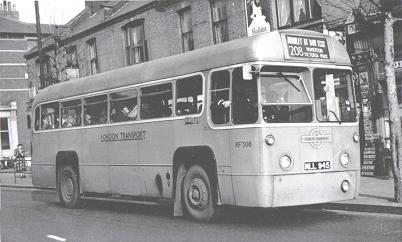 Red RF
routes Red RF
routes
Route 208
Page last updated 1 December
2014
Originally numbered 108D, part of the 108 Blackwall
Tunnel route, the 208 was established in 1927 and has run over
roughly the same route ever since, although renumbered as the
flat-fare S2 in 1970 and 488 in 2008. Another of the early RF
conversions in 1952/3, the 208 was the last route to run LTL
Scooters.
RF308 - as it then was - in
original condition, busy as usual, running south to Bromley by Bow
in 1954. Note the full blind, rather than the lazy blind
later used. This was one of Dalston's first batch of RFs,
delivered new for the 208A,
and one of those renumbered in March 1956 in order to keep the
fleet numbers of Green Lines, Country buses and red buses in tidy
batches. Whilst still at Dalston, it became RF527. The
replacement RF308 is now preserved.
Photo © Alan Cross
Dates of RF operation
12 Oct 52 (weekends, see notes) and 31 Jan 53 (Mon-Fri)
to 17 Apr 70
(total 17 years 6 months, all crew operation)
Destinations
CLAPTON POND and BROMLEY BY BOW
RF Garages
D Dalston
 Reasons for single-deck operation Reasons for single-deck operation
Low bridges in Kenworthy Road and Fairfield Road.
Dalston's 5Q5 Q139 is seen
southbound in Urswick Road, loading more into what looks already a
pretty full bus (note the five ladies on the 5-seater long
seat over the engine). Not bad for a route that ran every
three or four minutes. Note the entrance ahead of the front
wheels, a feature not shared by the Country or Green Line Qs.
Photo © PJ Marshall, Peter
Gomm collection
Route history
The Blackwall Tunnel opened in 1897, featuring the sharp
corners still evident in the northbound tunnel today. The
first motor bus route through the tunnel operated by LGOC,
replacing a Tilling horse bus service, commenced on 21 Nov
1912. Metropolitan Police concerns about clearances resulted
in this being single-deck operated, the first LGOC single-deck
route. This was numbered 69, running from Poplar to
Plumstead (altered the following June to run to Greenwich
Woolwich Road) and was worked by Athol Street garage,
Poplar, (C) using B types. On 29 Mar 14, the 69 was
renumbered 108 and extended to run from Bow, the southern
section being extended to Blackheath for a few months
only.
Associated route 108 A, a much extended version of
the 108, commenced operation on 29 Nov 22, running from Clapton Pond via Bow and Blackheath to Lee Green
and operated by Dalston (D) and Hackney (H) garages. Three
months later, the route was diverted at Blackheath to run to
Lewisham and H was replaced by C. October 1923 saw the route
extended via Catford to Forest Hill, and another route,
108 B, introduced from Poplar to Southborough via
Lee Green and Bromley. During 1922-23, the Bs were
replaced by new single-deck Ss.
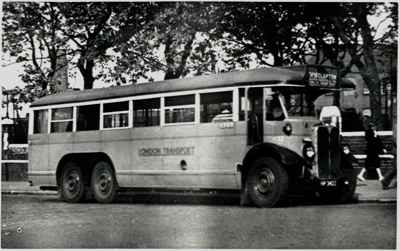 LT1132 sits in Bromley High Street before
returning to Clapton Pond - note the detailed blind display. Photo Peter Osborn
collection
The 1924 Bassom numbering
scheme grouped short workings under the same main
number, but bifurcations into related numbers, so the Clapton Pond
to Forest Hill route became 108, with various short workings
numbered 108 A to 108 E; 108 B became
158. The route was heavily used and discussions
commenced with the Metropolitan Police regarding double-deck
operation, leading in 1927 to the prototype 'tunnel' NS, lower and
with a specially curved roof and curved enclosed rear end.
NS2050, which ran alongside the Ss over that summer, was
a success and led to the construction of 24 similar
buses.
The northern section of the route was however not suitable for
double-deckers due to low bridges in Kenworthy Road and Fairfield
Road, so on 19 Oct 27, the 108 was split at Bromley by Bow into the NS-operated
108 B to Forest Hill (with other-suffixed short-workings)
and the S-operated 108 D to Clapton Pond; the full
registered route 108 ceasing to operate although through fares
were offered (until at least 1936). The
108 B was worked by Athol Street (who needed to retain a
few single-deck Ss until sufficient NSs were available a couple of
months later), the 108 D by Dalston.
In 1929, D was joined on the 108 D by Tottenham (AR)
on Sundays, initially using Dennises and a K, later just Ks; Ks
also replaced some of the Ss at D. Twelve new LTL Scooters
were delivered to Dalston in May 1931 to replace the Ss and Ks,
shortly afterwards AR's contribution (spare on Sundays from the
263) was also converted to LTL.
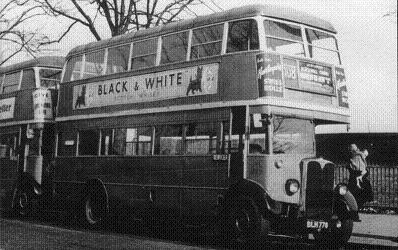 Standard STL719 in Crystal Palace Parade, awaiting
departure through the Blackwall Tunnel to Bromley-by-Bow, where is
will connect with the 208. This must be in 1953, the year
that the tunnel was re-profiled, as the bus was withdrawn at
the end of that year. Photo Ian Armstrong
collection
With most routes now operated by pneumatics tyred buses, for
which the speed limit was 20mph rather than 12mph, a programme of
speeding up routes using the same frequencies resulted in more
efficient use of buses. This was applied to the
108D, where D's allocation reduced by one from November
1932.
In October 1934, the 108 B was renumbered 108 and
the 108 D as 208 in the single-deck sequence. The 208
continued to be LTL-operated from D, with the weekday allocation of
10 increased to 12 at weekends and augmented by 3 from AR on
Saturdays, now the busiest day. From 1936 to 1938, the D
allocation switched from LTL to Q, then back to LTL until 1943,
with Qs again for the ten years until replaced by RFs at the
beginning of 1953. Meanwhile the AR allocation
fluctuated between LTL, Q and T types until ceasing in 1943.
The route was the last to operate Scooters, with
Dalston's last three buses appearing occasionally, although no
longer scheduled, until withdrawal on 31 Jan 53.
Meanwhile in the tunnel, the NSs (the last solid-tyred buses
running in London) were replaced in 1937 by the tunnel STLs, again
specially shaped (see photo here). These lasted until the tunnel
was re-profiled (by raising the roadway) in 1953, when they were
replaced by normal STLs (temporarily) and RTLs. These
retained the strengthened tyres of the tunnel STLs to address the
scuffing of the kerb.
RFs replaced Scooters on sister route 208A, which operated Monday to
Saturday only, between 9 and 17 Oct 52, for which Dalston
received 14 RFs. They were doubtless immediately put to work
on the 208 at weekends as well - with 3 buses licensed by the first
weekend, they probably worked the 208 A on Saturday and
appeared first on the 208 on Sunday 12 Oct 52. By 22 Oct 52,
the official allocation on the 208 included 8 RFs on
Saturday and 14 RFs on Sunday, meaning that the whole allocation
worked at weekends, an indication of the pressure on the new
buses.
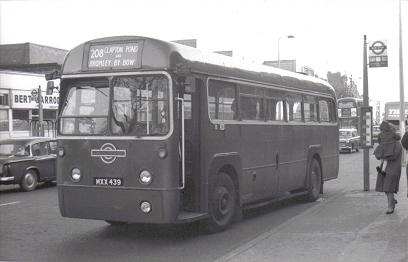 Already fitted with doors, RF462 turns into Clapton
Pond from Lower Clapton Road, some time between 1966 and 1968; the
original blinds have given way to lazy blinds. The RT in
the distance is on the 106 - the background also features in
the Hackney photo gallery. Photo
© M Rooum, Peter Gomm
collection
The 208 had to wait until January 1953 for its own buses, the
first two RFs (413 and 414) were licensed on 16 January to
enable the Scooters to retire, with the remaining batch licensed
between 4 and 9 Feb 53. LTs 1157, 1172 and 1195
were finally withdrawn from Dalston on 31 January, the last LTs
available for service in London and the end of a 22-year reign
and the last 'big six-wheelers' until modern times.
in June-July 1953, and again in April 1957, there were
historical echoes when Dalston RFs worked a short section of the
108 during road works on St
Leonard's Street, Bromley by Bow, as the diversion route ran under
a low bridge in Devons Road.
Between November/December 1953 and April 1954, the RFs were
joined on the 208 by three experimental buses on trial, still in
their green livery. These trials were primarily for Country
Area purposes, as it was expected at the time that service
expansion would require additional buses following the completion
of RF deliveries. By then, newer lightweight buses were
available, and in addition to trials at Reigate on the 447 and 711,
they were tested on the 208 as being a tortuous, heavily-used
route. The three were Bristol LS5G PHW918 (which at 6¼
tons and manual gearbox seems hardly to qualify), AEC Monocoach
NLP635 and Leyland Tiger Cub PTE592, the latter two at
about 5½ tons and with semi-automatic transmission. Before a
choice was made, however, requirements were revised downwards and
in the end no more single-deckers were acquired by LT until
the Merlins in 1966.
A very high frequency route, the 208 was still operating every
3 minutes at certain times on Saturdays through to the end of the
1960s. Because of its high loadings, it was initially
uncertain that it could be converted to one-man operation, but this
came with conversion to flat-fare MBS buses in 1970 and a
renumbering to S2. The last RF to run on the 208 on 17 Apr 70
was RF400 running as D9; LOTS reported that it was decorated with
commemorative hand-written leaflets.
MBSs were in turn replaced in 1973, when the S2 became the
proving ground for two new vehicle types, the LS Leyland National
and the MS Metro-Scania, with six of each. The MS type was
forever associated with Clapton Pond after, on the first day of
operation, one ended up driving into the pond, but they did not
stay long and were replaces by LSs in 1979.
The S2 followed much the same route as the 208, except
that it avoided the narrow Cadogan Terrace, and was extended to
serve Stratford. In 2008 it was in turn replaced by the 488,
which now overlaps the 108 for a short distance.
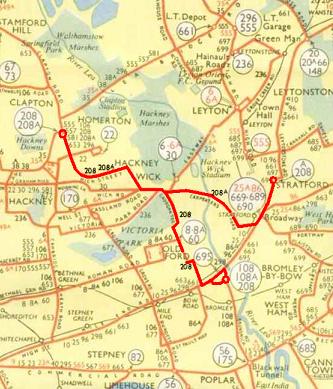 RF route
in detail RF route
in detail, with timing points
CLAPTON POND, Lower Clapton Road, Clapton Urswick Road, Urswick
Road, High Street Homerton, Kenworthy Road, Wick Road, Hackney Wick Cadogan Terrace,
Cadogan Terrace, Jodrell Road, Old
Ford Lady Franklin, Parnell Road, Tredegar Road,
Fairfield Road, Bow Road, High Street Bromley, BROMLEY BY BOW
Seven Stars
Garage journeys from D: to/from Lower Clapton Road Urswick
Road via Hackney Central Station, Mare Street, Westgate
Street
1955 bus map © London Transport
Frequency
| Year |
Mon-Fri |
Sat |
Sun |
| 1936 |
5 mins |
3-4 mins |
3½-4 mins |
| 1941 |
5 mins |
3-5 mins |
4 mins |
| 1946 |
4-5 mins |
3-5 mins |
3-6 mins |
| 1951 |
4-5 mins |
2½-6 mins |
3-5 mins |
| 1959 |
4-7 mins |
3-4 mins |
3-8 mins |
| 1964 |
4-8 mins |
3-4 mins |
5 mins |
The route took about 20 minutes from Clapton Pond to
Bromley by Bow. The November 1959 timetable is
here, the July 1967
timetable here.
Faretable
To view the faretable for May 1965, including garage
journeys, click here.
RF allocation
New RFs delivered Jan 53 (advance for LTL replacement):
413-414, Feb 53: 437, 440-442, 444-448, 465, 468, 474, total
14.
PVR 1952 (Oct): Mon-Fri 13Q, Sat 10Q/8RF, Sun
4Q/14RF
PVR 1953 (Feb): Mon-Fri 13, Sat 18, Sun 18
Nov 53 to Apr 54: Experimental Bristol PHW918 and Leyland
Tiger PTE592 allocated to D for 208
PVR 1955 (Mar): Mon-Fri 13, Sat 15, Sun 16
PVR 1955 (Aug): Mon-Fri 13, Sat 18, Sun 16
PVR 1958 (Nov): Mon-Fri 12, Sat 16, Sun 16
PVR 1963 (Oct): Mon-Fri 12, Sat 16, Sun 13
PVR 1966 (Jul): Mon-Fri 11, Sat 14, Sun 13
PVR 1966 (Dec): Mon-Fri 12, Sat 14, Sun 12 (note that D
was only allocated 12 RFs. An additional 3 Saturday vehicles were
usually borrowed from T, AR and TB although in latter years E also
supplied some)
Memories
Brian Elliott worked at
Dalston garage in the early sixties and remembers driving
RFs:
‘We would to call them the Scooters, the 208 from Clapton Pond
to Bow Station was really only a short run in a circle. I think it
was three runs before we got a break - there was a coffee stall at
Clapton Pond where we had our snack - and if it was a spread-over
you come back later in the day for another few runs. The route was
more or less straightforward and the only time you could miss a run
was perhaps on a Saturday when Roman Road market was in full swing.
Because the RFs had no doors, the conductor was always at the back
if possible, and the trick was to catch the bus in front of you so
your clippie did not have too much work to do.
I remember there used to be a cafe next to Dalston garage
back in the sixties and the food was great, but alas long
gone. I have been living in Ireland for the last 40
years, but I used to go home when my parents were alive and
visit Shrubland Road and reminisce.
Apart from the 208, I drove the RTLs until they replaced them
with the RMs. Although the RM had powered steering, I preferred the
RTL with its pre-select gearbox. I was on the 11, on that route you
might go as slow as possible to get a turn so you got some overtime
- you might get turned at the roundabout by the Houses of
Parliament on your way to Wells Road, Shepherds Bush.
I sometimes did the 9 and the 47 – I remember starting at
Shoreditch Church and going to Catford in the week; I’m not to sure
if we went to Farnborough on the Sunday but I know we went past
Catford. I used to dislike the route as I always had the fear of
getting lost; when you live on the north side of London crossing
the river was going into another land.
I did my PSV driving test at Enfield garage - as you know the
instructor sat behind you in the front seat with the glass removed
so he could talk to you. I thought he was old because when you are
young everybody is old, but he used to take snuff and his
handkerchief was dark brown from sneezing in to it – I wonder if
anybody remembers his name. He was a good old stick - he was always
on to me for driving too close to other traffic when overtaking,
but he really was good and put me at my ease on the skid test.'
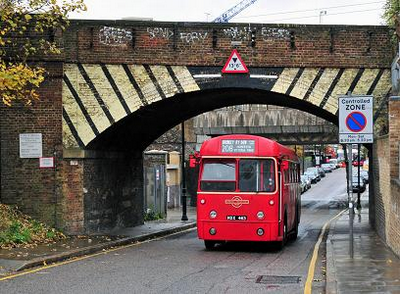
Re-creation
RF486 nears Bow Garage
under one of several low rail bridges on the 208 route. The
occasion was the marking of 100 years since the first single-deck
route in London. See also David Christie's picture of RF467 here in 1970. Photo © Steve
Whitelegg
|
|